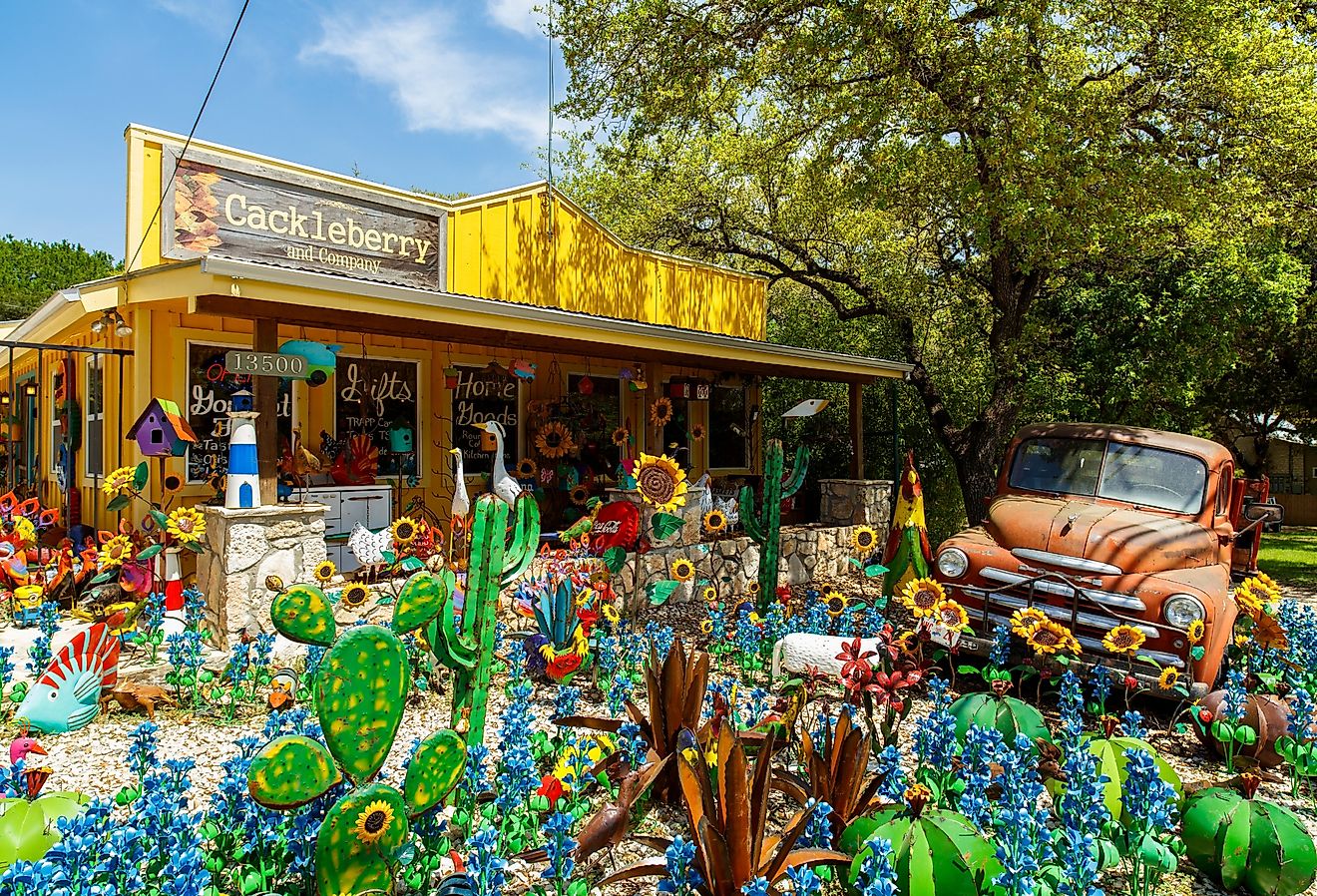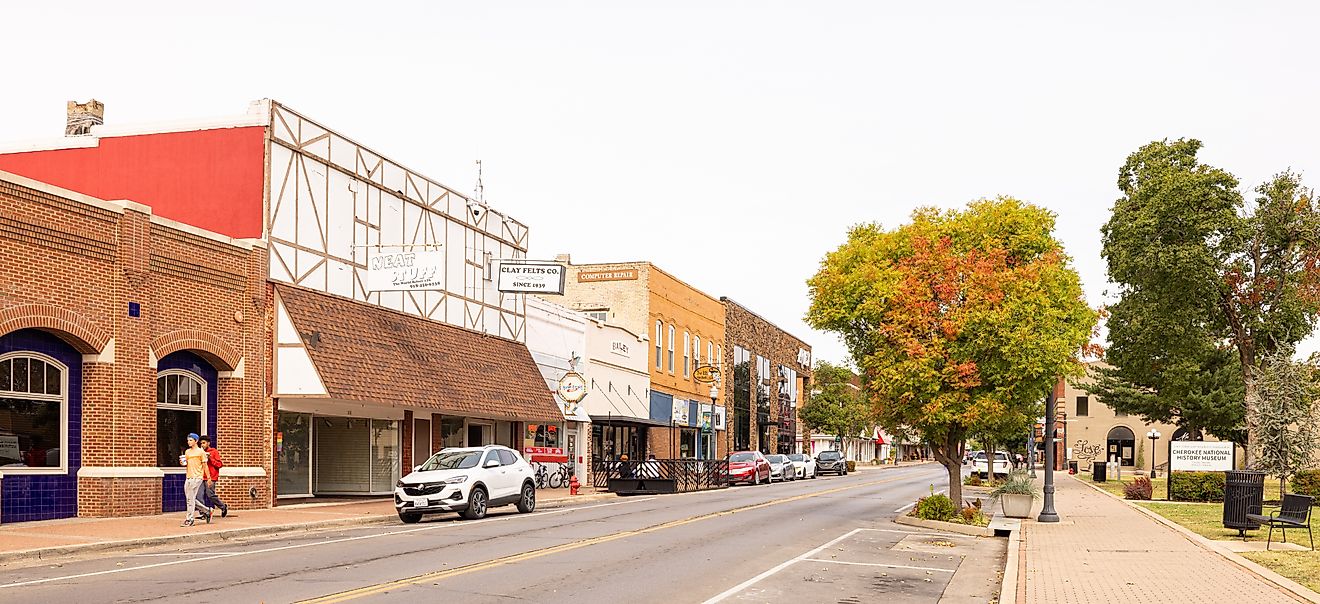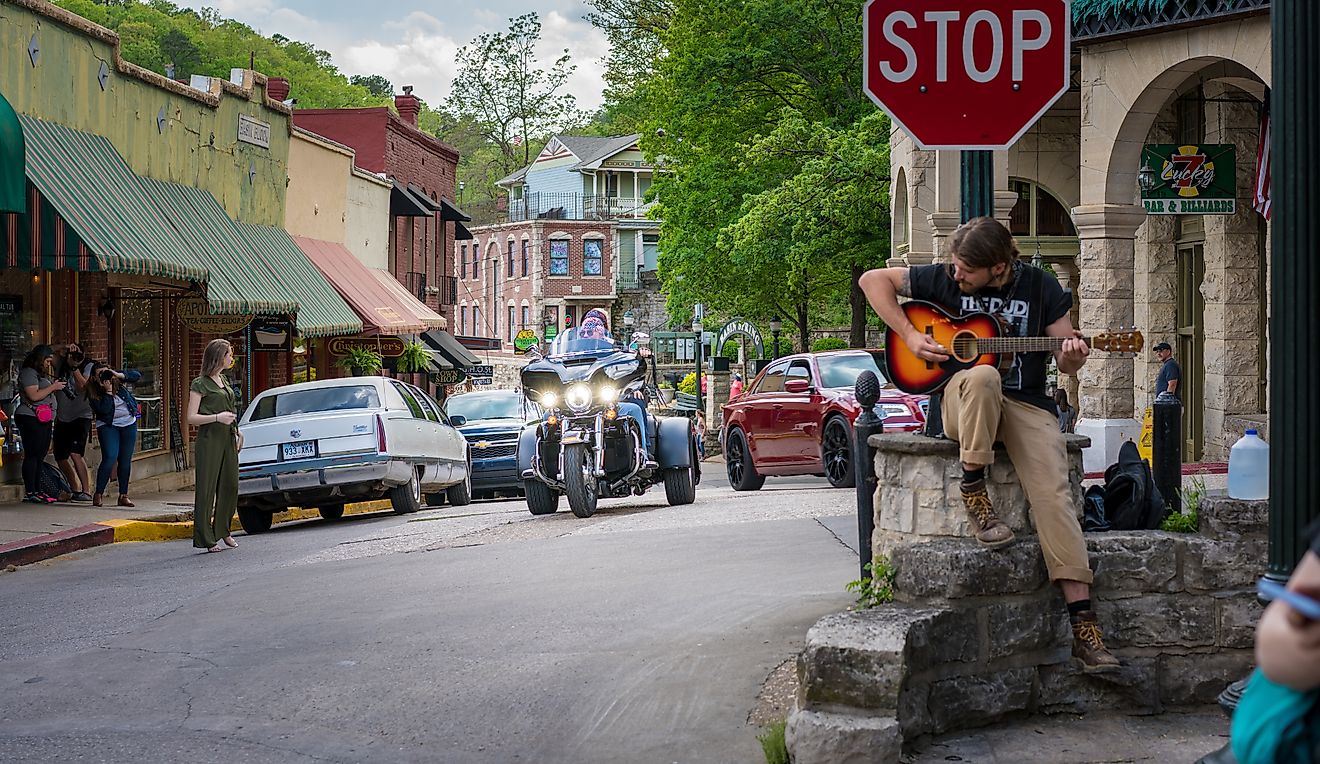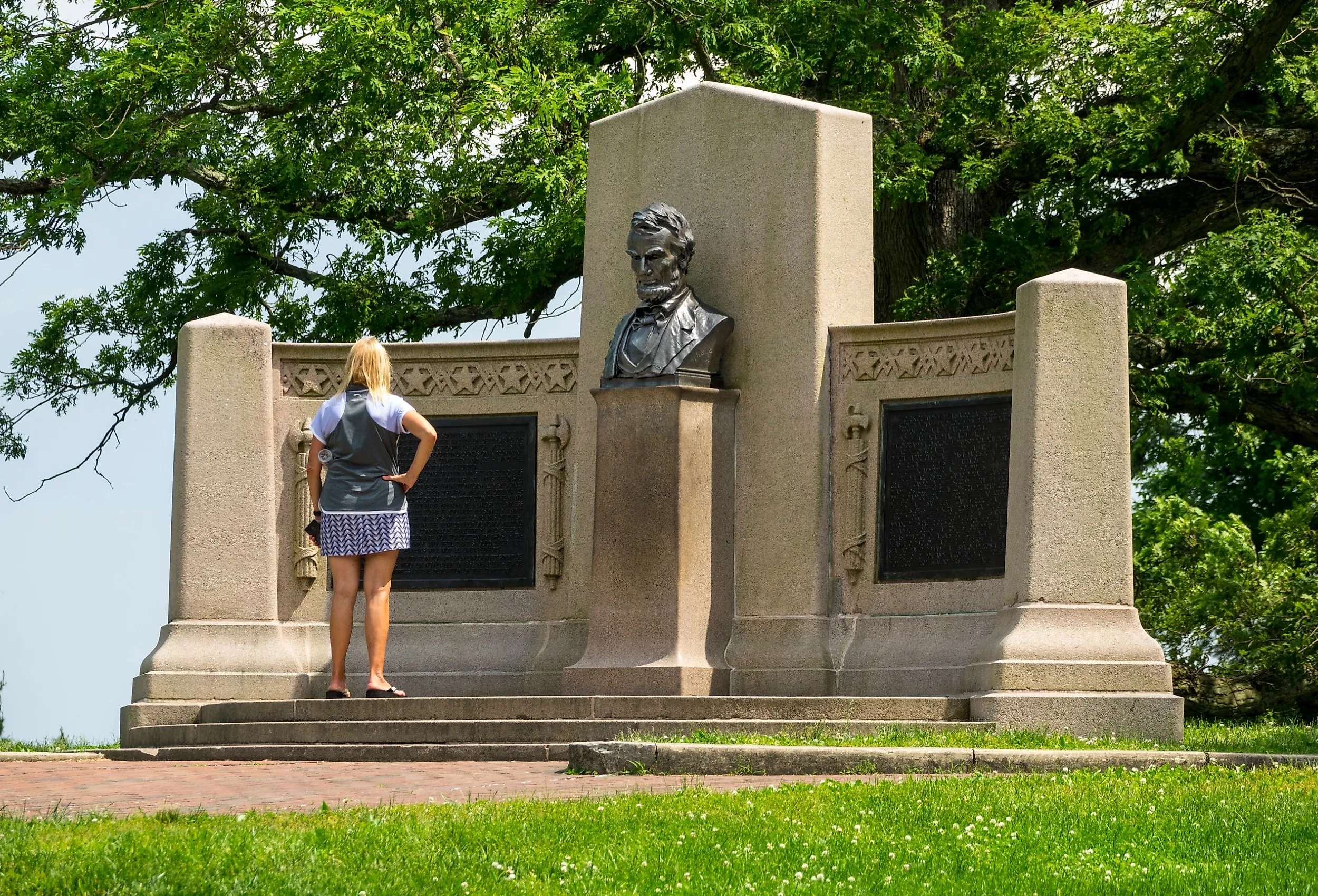
Top 7 Civil War Monuments In Pennsylvania
Pennsylvania played a pivotal role in the Civil War—not only as the site of the Battle of Gettysburg, but as a home front that supplied troops, arms, and leadership to the Union's cause. Today, its landscape is dotted with monuments that commemorate sacrifice, valor, and the long, complicated journey toward unity and justice. These sites serve as reminders of the price of division and the courage of those who stood for freedom and national preservation. Each of these Civil War monuments tells a story worth pausing for—both to honor the lives lost and to better understand the events that helped shape the nation.
Pennsylvania State Memorial - Gettysburg
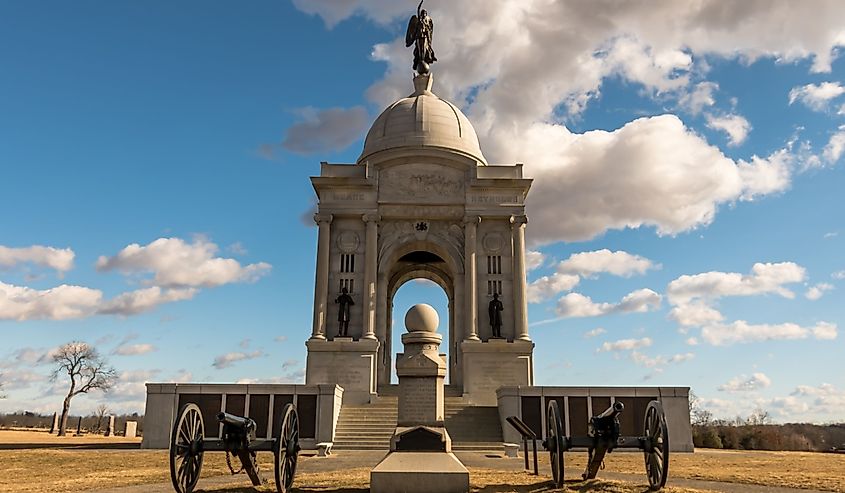
Standing tall and proud on the Gettysburg battlefield, the Pennsylvania State Memorial is the largest and perhaps the most stirring monument on the historic site. The shrine honors the 34,000 Pennsylvanians who fought in the Battle of Gettysburg, many of whom never returned home. At the monument’s base is a four-sided granite terrace with bronze tablets engraved with the names of every Pennsylvania soldier who fought there.
The monument embraces a neoclassical style, with a granite domed pavilion topped with a bronze statue of Nike, the goddess of Victory. This statue is significant because she holds a raised sword in one hand and a palm branch in the other, symbolizing victory and peace. Life-size statues of Abraham Lincoln and other Civil War dignitaries flank the pavilion's arches.
Visiting here offers more than just a photo opportunity. As a monument should, the Pennsylvania State Memorial offers space to reflect on the war’s scale and the state’s immense contribution. The surrounding fields bring the battlefield to life, and ranger-led tours give context that deepens the experience. For anyone interested in American history, this is a must-visit—solemn, powerful, and unforgettable.
Soldiers and Sailors Monument - Allentown
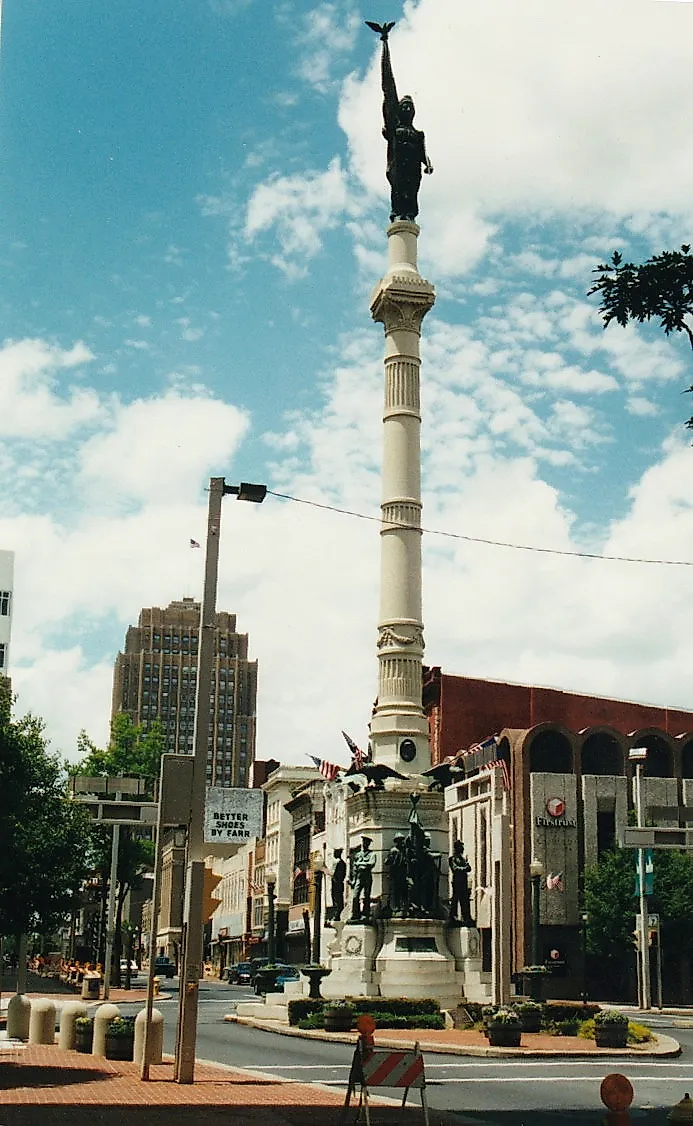
In the heart of Allentown’s Center Square stands the Soldiers’ and Sailors’ Monument, a towering 99-foot granite monument topped with the statue of the Goddess of Liberty. Dedicated in 1899, it began honoring Lehigh County’s Civil War veterans who served to preserve the Union. However, the monument was expanded in the late sixties to honor locals who served in later American conflicts.
What sets this monument apart is its striking central location and the fact that it’s been part of the community’s rhythm for over 125 years. It is a testament to Civil War service, particularly the local boys who answered Lincoln’s call. The four bronze plaques at the base are moving. Each lists the names of the fallen and bears scenes of sacrifice and unity. Each side of the memorial depicts a different scene, while three detail a theme of war, one of its columns, dedicated to the theme of unity, depicts two soldiers—one Union, one Confederate—linking arms in the spirit of “One Flag, One Country.”
This monument mirrors the resolve of those who fought and sacrificed to keep the Union together. Its prominent location also means you can enjoy Allentown’s revitalized downtown after your visit—cafés, shops, and a history walk hand in hand.
Major General George Gordon Meade Statue - Philadelphia
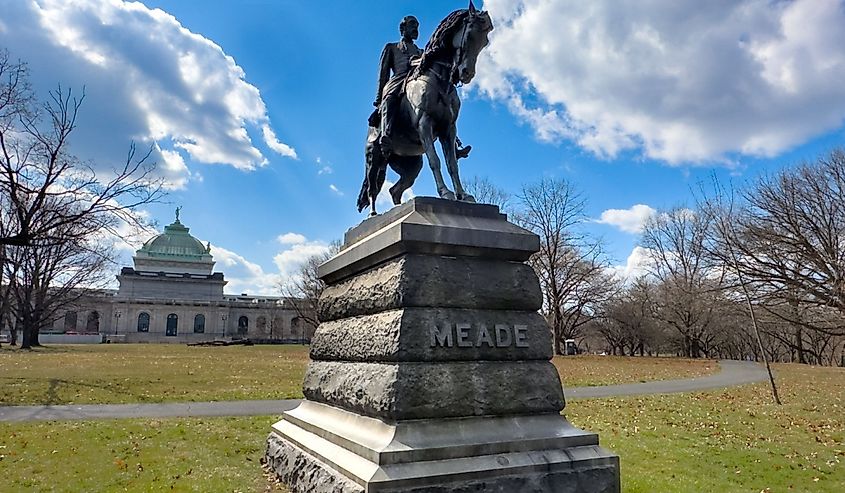
Major General George Gordon Meade’s equestrian statue rises with quiet dignity in Fairmount Park, honoring one of Pennsylvania’s most critical Civil War leaders. A Philadelphia resident, Meade led the Union Army to victory at Gettysburg—a battle that marked a turning point in the war and preserved the nation’s future.
Sculptor Alexander Milne Calder completed the statue in 1887. It portrays Meade in full military uniform astride his horse. Rather than dramatize the moment, Calder gave Meade a stern, focused expression, reflecting the heavy responsibility of command and the seriousness with which Meade approached it.
Fairmount Park offers a peaceful setting for this monument, with the statue facing Laurel Hill Cemetery, where Meade is buried. Visiting the site connects you with a lesser-known but essential leader—someone who didn’t seek the spotlight but helped save the Union with determination and strategic skill. Meade’s legacy continues to speak through bronze and stone, urging future generations to lead with integrity and resolve.
The Friend to Friend Masonic Memorial - Gettysburg

This quiet yet powerful monument sits in the Gettysburg National Cemetery Annex and offers a profoundly human story amid the scale of war. The “Friend to Friend” Masonic Memorial depicts Union Army Captain Henry Bingham assisting Confederate General Lewis Addison Armistead, who was mortally wounded during Pickett’s Charge.
While the two men stood on opposite sides of the war, they were both Freemasons. The statue captures the exact moment Union forces found the wounded Armistead, depicting the care Bingham offered the dying man in his final moments. Though the war forced them into opposing roles, the bonds of brotherhood lingered. It is a powerful reminder that even amid conflict, compassion can survive.
This is not a grand battlefield monument—it’s a human story captured in bronze, nestled within the cemetery grounds. If you’re visiting Gettysburg, don’t overlook this memorial. It’s a powerful reminder that even amid conflict, compassion can survive.
11th Pennsylvania Volunteer Infantry Monument - Gettysburg
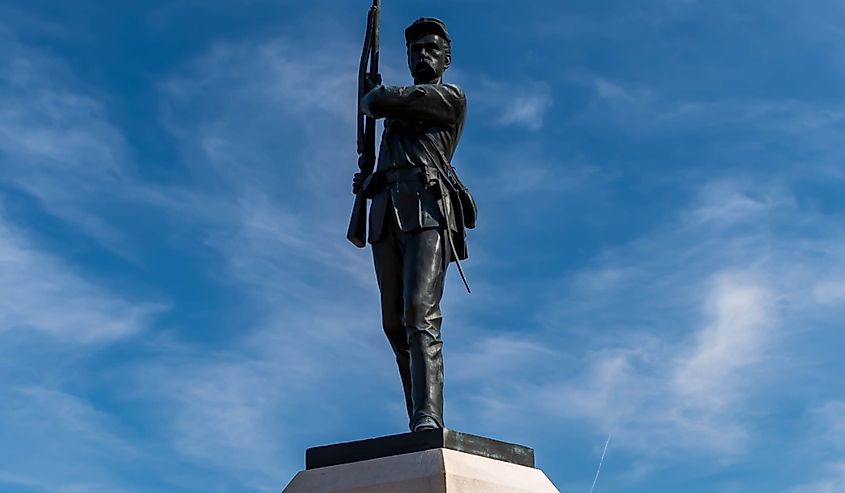
This monument, located near Oak Ridge, honors the 11th Pennsylvania Infantry—a regiment known for its discipline, bravery, and a rather unusual mascot: Sallie, the dog who marched with them. At the base of this solemn monument lies a bronze statue of a small dog, curled up as if still keeping watch over her regiment.
The 11th fought in numerous battles, including Gettysburg, and suffered heavy losses. The regiment’s story—one of perseverance, loyalty, and shared hardship—is etched into the faces of the fallen and remembered in Sallie’s quiet presence. During the Battle of Gettysburg, Sallie was separated from the unit but returned days later, found standing guard over the wounded and dead.
This is one of those monuments that sneaks up on you emotionally. It’s not massive or flashy, but it’s deeply human. It represents the unbreakable bond among soldiers, the loyalty that transcends words, and the personal losses behind the grand narrative of war. Visitors often leave a small treat or token at Sallie’s feet—a biscuit, a penny, a flower. If you're walking the battlefield, stop here. Pay your respects to the men—and one faithful dog—who stood together in one of the war’s bloodiest chapters.
Lincoln Address Memorial - Gettysburg National Cemetery
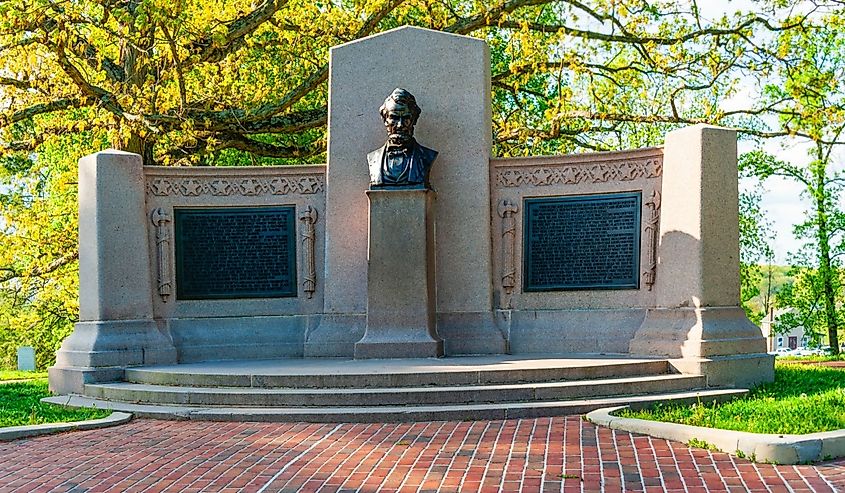
Tucked within Gettysburg National Cemetery, the Lincoln Address Memorial marks the site where President Abraham Lincoln delivered one of the most powerful speeches in American history. On November 19, 1863, just months after the bloodiest battle ever fought on U.S. soil, Lincoln stood near this spot and spoke fewer than 300 words that forever changed the nation's course.
The memorial, installed in 1912, features a bronze bust of Lincoln set into a granite pedestal. Carved into the stone beside him, the full text of the Gettysburg Address reminds visitors of the speech's enduring message. Rather than glorifying battle, Lincoln chose to honor sacrifice and reframe the war as a test of the American ideal—that all people are created equal.
The surrounding stillness gives the site a gravity that words alone can’t capture. Reading the address where it was spoken, just steps from the graves of thousands of Union soldiers, brings a deeper connection to both the speech and the moment in which Lincoln gave it.
Lincoln’s call for a “new birth of freedom” resonates today. Whether you're a history enthusiast or a casual traveler, standing before this modest but powerful memorial offers a moment of reverence, clarity, and a renewed appreciation for the values that continue to define the nation.
Soldiers and Sailors Memorial Hall - Pittsburgh
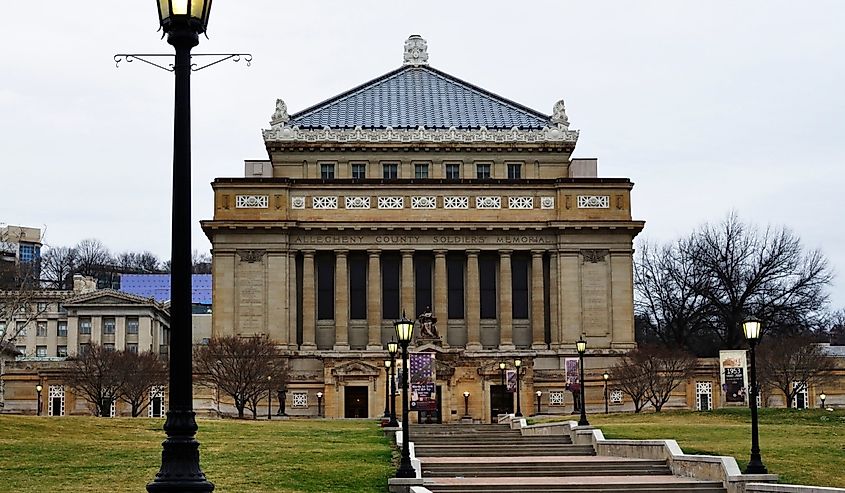
Built between 1908 and 1910, Pittsburgh’s Soldiers and Sailors Memorial Hall is one of the few monuments in Pennsylvania dedicated not only to Civil War veterans but to all who served in the U.S. Armed Forces. However, its foundation and first purpose were deeply rooted in honoring those who fought to preserve the Union.
The building’s Beaux-Arts architecture alone is worth the visit, but inside, the true treasure lies in the museum. Exhibits cover Civil War history extensively, including Union uniforms, weaponry, and personal letters from Western Pennsylvania soldiers. You’re not just looking at artifacts—you’re connecting with stories of real people who made unimaginable choices.
Outside, a bronze statue of Abraham Lincoln reminds visitors of the president whose leadership held the nation together and whose life was ultimately taken by those who opposed emancipation. The whole site fosters reflection on what it means to serve, to sacrifice, and to stand against injustice.
The Memorial Hall also serves as a community space, hosting lectures, naturalization ceremonies, and public discussions. Its ongoing use keeps history relevant. Whether you're a history buff or curious about Pennsylvania’s role in the Civil War, this is a rich, engaging stop. It educates without sugarcoating and commemorates without glorifying conflict. The building and the collections remind visitors how important it is to preserve the perfect union our founding fathers created.
Conclusion
Pennsylvania’s Civil War monuments offer more than just stone and bronze—they offer insight, memory, and connection. They honor those who fought to preserve the Union and end slavery, and they serve as enduring lessons on leadership, courage, and the price of disunity. From Gettysburg’s iconic battlefield markers to quiet corners in cities like Allentown and Pittsburgh, each monument asks us to remember, to reflect, and—most importantly—to learn. These sites aren’t relics of the past; they’re invitations to better understand who we are and what we stand for.
